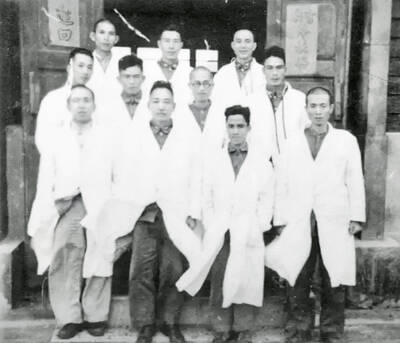The first thing that needs to be noted about Tanhou is that it is far more than just a restaurant. In fact, people passing by are likely to mistake it for a posh or gourmet supermarket. The large establishment consists of a bakery, a dry goods market, a frozen meat and fish section, a shabu-shabu counter and a coffee, juice and snack counter on the ground floor. The area for formal dining is in the basement. What makes Tanhou stand out from other places that offer healthy and natural foods is that this location is the retail face of a huge natural and organic foods production enterprise that includes its own fishery, pig and chicken rearing operations, and organic farm.
“Natural” and “organic” are words that are bandied about rather willy-nilly in this health-conscious age, and CEO Liu Tien-ho (劉天和) is careful not to make excessive claims for the food he sells. The fish and meat are “natural,” reared without the aid of growth hormones and antibiotics. It is only the vegetables that are strictly “organic.” The restaurant serves food prepared exclusively from Tanhou’s agricultural operation and affiliated farms, and as Tanhou has, until recently, primarily been involved in export, its products conform to a slew of international certifications including HACCP, one of the most stringent food safety assurance standards. Even the herbs used in the cooking are grown on Tanhou farms.
The restaurant, which had its soft opening last week, offers set menus (NT$480 to NT$880) designed to show off the quality of the foods on sale upstairs. Currently the menu favors very simple preparations. A salad of nuts and raw vegetables with an almost invisible vinaigrette impressed with the sweetness of the individual elements — the slices of red onion were so flavorful they could have been enjoyed unaccompanied. A portion of sashimi hit home with the delicacy of its flavors and the use of freshly ground wasabi. The oysters in a mixed appetizer were the most succulent local oysters that I have tasted in Taiwan, though the addition of a richly flavored sauce was an unfortunate distraction. While part of Tanhou’s appeal must certainly lie in the guarantee it offers regarding all of its ingredients, the food itself is competently prepared and staff is helpful in explaining each dish as it arrives. A good range of French and Californian wines is also available. And for those in a hurry, there is a selection of lunch boxes including pork and egg fried rice (海藻豬油蛋炒飯便當, NT$80) and steamed fish (鮮物魚片便當, NT$150). Vegetarian menus are also available.
The bakery upstairs is a must-visit for anyone interested in good bread, with some of the best white bread on offer in the city, as well as excellent brioches, baguettes and a selection of fancy breads. This is proper Western-style bread, sold at reasonable prices, with no fluffy pork in sight. The dry goods area features both local and imported organic goods, ranging from fruit preserves, condiments and rice to environmentally friendly household cleaning products.

That US assistance was a model for Taiwan’s spectacular development success was early recognized by policymakers and analysts. In a report to the US Congress for the fiscal year 1962, former President John F. Kennedy noted Taiwan’s “rapid economic growth,” was “producing a substantial net gain in living.” Kennedy had a stake in Taiwan’s achievements and the US’ official development assistance (ODA) in general: In September 1961, his entreaty to make the 1960s a “decade of development,” and an accompanying proposal for dedicated legislation to this end, had been formalized by congressional passage of the Foreign Assistance Act. Two

Despite the intense sunshine, we were hardly breaking a sweat as we cruised along the flat, dedicated bike lane, well protected from the heat by a canopy of trees. The electric assist on the bikes likely made a difference, too. Far removed from the bustle and noise of the Taichung traffic, we admired the serene rural scenery, making our way over rivers, alongside rice paddies and through pear orchards. Our route for the day covered two bike paths that connect in Fengyuan District (豐原) and are best done together. The Hou-Feng Bike Path (后豐鐵馬道) runs southward from Houli District (后里) while the

March 31 to April 6 On May 13, 1950, National Taiwan University Hospital otolaryngologist Su You-peng (蘇友鵬) was summoned to the director’s office. He thought someone had complained about him practicing the violin at night, but when he entered the room, he knew something was terribly wrong. He saw several burly men who appeared to be government secret agents, and three other resident doctors: internist Hsu Chiang (許強), dermatologist Hu Pao-chen (胡寶珍) and ophthalmologist Hu Hsin-lin (胡鑫麟). They were handcuffed, herded onto two jeeps and taken to the Secrecy Bureau (保密局) for questioning. Su was still in his doctor’s robes at

Mirror mirror on the wall, what’s the fairest Disney live-action remake of them all? Wait, mirror. Hold on a second. Maybe choosing from the likes of Alice in Wonderland (2010), Mulan (2020) and The Lion King (2019) isn’t such a good idea. Mirror, on second thought, what’s on Netflix? Even the most devoted fans would have to acknowledge that these have not been the most illustrious illustrations of Disney magic. At their best (Pete’s Dragon? Cinderella?) they breathe life into old classics that could use a little updating. At their worst, well, blue Will Smith. Given the rapacious rate of remakes in modern